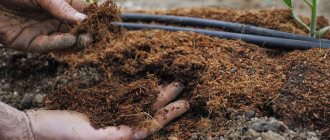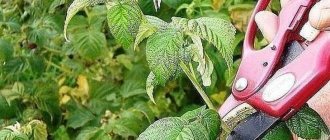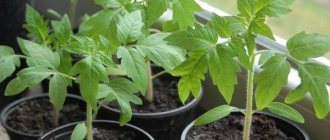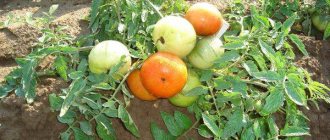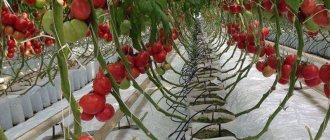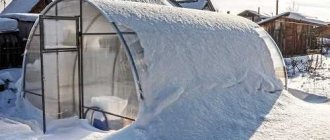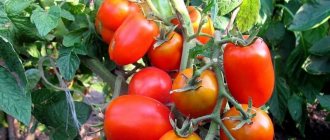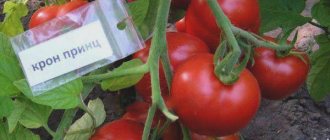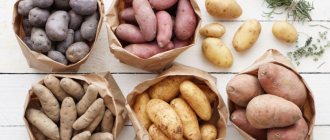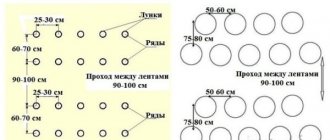Which varieties are best?
There are many varieties of basil, they differ in size, leaf color and aroma. Different varieties coexist well with each other and do not cross-pollinate, so several varieties can be planted at the same time.
The following varieties are best suited for growing in greenhouse conditions:
Purple basil is highly valued in Caucasian and Indian cuisine as a seasoning for sauces, side dishes, meat dishes and desserts. The leaves can be of various shades: from soft purple to rich dark purple.- Cinnamon is a compact plant with light green leaves that has the taste and aroma of cinnamon.
- Lemon is a spreading bush with lush foliage of a light green hue and the aroma of lemon.
- Camphor is a very beautiful plant with bright green foliage and exudes a pleasant clove aroma. This variety is most popular in Mediterranean cuisine.
Pests and diseases of basil
Basil is a whimsical plant. If you do not follow the rules of care, it can be affected by infectious diseases and insect pests:
- Black leg appears due to frequent watering, insufficient air supply to the roots, and increased acidity. The disease can be recognized by softened stems and curled leaves. For treatment, “Topaz” and “Fitosporin” are used.
- Gray mold often affects greenhouse basil. At the initial stage, dry brown-gray spots appear on the leaves. Without treatment, they become watery and covered with a gray coating. When the first signs of the disease appear, the plant is sprayed with onion infusion.
- Aphids feed on plant sap. As a result, basil stops developing, the leaves turn yellow, dry out and fall off. To combat the pest, folk remedies are used - infusion of hot pepper, wormwood, garlic.
How to prepare a greenhouse structure?
Depending on the region and its climatic conditions, the requirements for greenhouse construction depend. For example, for the central regions of Russia, when planting basil early, greenhouses made of glass or cellular polycarbonate are perfect. These materials transmit light and retain heat well.
The size of the greenhouse can be absolutely any, because in addition to basil, other crops can be grown there at the same time. It is best to place the structure in a sunny place, away from large trees. It is imperative to provide vents, as ventilation is indispensable.
You need to start preparing the greenhouse for the new season in the fall:
- Clear of plant debris.
- Wash all surfaces, remove cobwebs (if any), treat with a disinfectant.
- Partially replace the soil (you can remove the top layer and add humus, peat and sand) and dig everything up. The soil must be loose!
Next in the spring the following actions are needed:
- Loosen the soil and treat with copper sulfate.
- Add mineral fertilizers (complex).
- Form ridges
Requirements for greenhouses
To grow basil in the cold season, you need to build a greenhouse. You will need to purchase materials, pay for installation and installation, but the cost of the resulting product will quickly pay for the costs.
Greenhouses are:
- Heated and unheated. To obtain early harvests, ordinary film shelters without heating are sufficient. But they are used only before frost sets in. To grow basil in winter in greenhouses, heating is necessary.
- Made of wood and metal profiles. The frame is made from these materials. The first option is cheaper, the second is stronger and more reliable.
- Arched or pitched. Another option is greenhouses, which have one blank wall adjacent to the wall of the house. This allows you to increase the temperature inside the building and save on heating.
- Made of glass and polycarbonate. For greenhouses without heating, a thick polyethylene film is sufficient. It can also be used for winter greenhouses if folded in two layers. But due to the fragility and fragility of the film, it has to be changed every year. But for regions with particularly harsh winters, this option is not at all suitable - film protection is not enough for Siberian frosts.
May be interesting Melissa and mint: how the plants differ How to properly store basil at home Parsley: a useful elixir for male potency
How to keep warm:
- In year-round greenhouses, heating equipment is installed that runs on electricity, coal, and gas.
- To maintain the temperature in unheated buildings, rotted manure mixed with straw is used - the mixture is laid on the beds, and after a few days it is covered with a layer of fertile soil.
- For additional heat, roofing felt sheets are laid out around the perimeter of an unheated greenhouse.
Any greenhouse structure should have easily opening windows so that it can be ventilated at any time. In frame glass and polycarbonate greenhouses, to prevent cold air from entering the greenhouse, a vestibule is made at the entrance. There are greenhouses with self-opening windows. If the temperature inside them rises above the established norm, the windows open themselves.
On a note!
In a greenhouse next to basil, you can grow crops that have similar requirements for soil, watering, temperature and humidity - green onions, parsley, dill, leaf and head lettuce.
Step-by-step instructions: how to plant?
Seeds
For good germination of basil seeds, they must be properly processed. Each seed of this plant is protected by a unique shell of essential oils, which can dissolve only in a favorable environment. Therefore, before planting it is worth doing the following manipulations:
Wrap the seeds in a cloth, pour hot water (about 50 - 60 degrees). Squeeze out excess water.- Wrap everything in a plastic bag and put it in a warm place (at least 25 degrees Celsius) for about 30 minutes.
- Unfold, the seeds should become covered with a slippery coating (the oils dissolve), then they can be sown in the prepared soil.
When sowing seeds, a certain order must be followed:
- Spill the soil (or filled containers) prepared in the fall with warm water.
- Make grooves with a depth of 0.5 cm to 1 cm at a distance of 30 cm from each other.
- Sow the seeds, leaving about 3 - 5 cm between them and mulch. Containers can be covered with film.
- After about 10 days, shoots will appear. As soon as 2 true leaves grow, the excess plants need to be removed, leaving a distance of about 10 cm between them.
Seedlings
Preparation of seedlings before planting in a permanent place is as follows:
- The temperature gradually decreases (you need to start reducing it 2 weeks before planting).
- Water with warm water (do not over-water).
When planting seedlings, the rules are as follows:
- It should be planted approximately a month after sowing the seeds (but no more than 45 days), and the bush should have 4–6 true leaves.
- There is no need to deepen the plants. Leave a gap of approximately 30–35 cm between the rows, and about 10–20 cm between the bushes (depending on the variety).
You will find all the details about basil seedlings in a separate article.
Purple basil: with what, then can you plant it in the beds in the garden?
Basil is known for its spicy aroma. Its leaves perfectly complement various meat dishes, salads, and sauces. In addition, the basil plant is often used in landscape compositions; the beautiful rich purple color of basil will become a decoration for flower beds. But they still love basil for its taste and aroma.
Among the varieties of purple basil are:
- Ararat
- Yerevan
- Pepper aroma
- Opal
- Vanilla
- Thai
Basil is sold in supermarkets, markets, and vegetable stalls; purchasing the spice is not a problem. But you can grow this plant at home if you know some of the subtleties of care. Basil is capricious. Sufficient lighting, suitable soil, and fertilizer are required. Without proper care, instead of abundant large leaves, you can get limp greens. Therefore, let's figure out what conditions need to be organized for growing an annual basil plant.
Purple basil
First you need to choose the right place to plant your seeds or seedlings.
Important: According to the rules for alternating crops in open ground, basil cannot be planted in one place for more than 5 years. If you do not adhere to this rule, a massive disease of all nearby plants with fusarium is possible.
Good neighbors for basil will be:
- Legumes. Basil prevents bean weevil from infecting legumes.
- Tomatoes. Fragrant basil has a positive effect on the taste of tomatoes.
- Bell pepper. Basil has a positive effect on the growth and development of sweet peppers.
Basil can be planted after potatoes and tomatoes. For a good harvest of these crops, fertilizers are usually used, which subsequently have a positive effect on the growth of basil.
Basil is often planted in the tree trunks. Basil drives away pests with its smell and phytoncides. Only trees need to be selected with a small crown so that the basil receives a lot of light.
Bad neighbors for basil are daikon and radish.
Neighborhood of crops in the garden
Care
To get a rich harvest, you need to properly care for basil, you need to create suitable comfortable conditions for it:
Temperature. Basil develops well at temperatures from 23 to 28 degrees. At temperatures below 15 degrees it may die.- Watering. Watering once a week will be enough. The most convenient way to do this is with a watering can with a wide spray nozzle or use drip irrigation.
- Weeding and loosening. It is imperative to remove weeds from the beds (by periodic weeding or manually). The plant is very responsive to loosening the soil.
- Humidity. Over-watering should not be allowed. If necessary, the greenhouse must be ventilated, but drafts cannot be created, they can cause great harm.
- Feeding. After the first cutting, be sure to water the plants well and apply fertilizer. You can use an aqueous solution of chicken manure or urea. Next, you should apply fertilizer after each cutting.
- Cutting. When the bushes reach a height of 20 cm, you can make the first harvest, that is, cutting (with pruners or a sharp knife), and you need to leave the stump with two leaves.
From one square meter per season you can get 2–7 kg of healthy aromatic greens.
Harvesting
When the plant reaches 10-15 cm, it can be cut off above 2 or 3 true leaves. Next, the row spacing is loosened and mineral fertilizing is applied. After 3 weeks, new shoots will appear from the leaf axils. In a good hot summer, 3-4 crops can be harvested from one bush. Harvesting is carried out before flowering, since during the appearance of inflorescences the shoots become rough and the leaves lose their rich aroma.
The harvest is stored dried and frozen
Important! Basil can be stored dried or frozen.
Basil is a very fragrant, healthy plant. Growing it in a greenhouse is not difficult. If you follow the planting and care rules, you can harvest 3-4 crops per season. The spice goes perfectly with meat dishes; it is used to prepare sauces, salads and side dishes.
Bad neighborhood
The following crops will be bad neighbors for it:
- Dill.
- Marjoram.
- Cabbage.
- Cucumbers.
- Radish.
- Ruta.
- Radish.
As a result, we can conclude that growing basil in a greenhouse is not at all difficult. Even novice gardeners get an excellent harvest; you just need to create suitable conditions for it: prepare the soil correctly, observe temperature and watering regimes, fertilize and loosen it in a timely manner. This royal herb is very responsive to attention and care and will certainly delight you with a bountiful harvest, its beauty and aroma. In a separate article you can learn when and how to harvest your basil.
If you decide to grow this aromatic plant, we suggest reading separate articles from which you will learn a lot of new and useful information about where to plant basil in order to get a good harvest and what are the features of cultivating this spice at home.
Features of growing for sale
To grow basil for sale, a heated greenhouse structure is required, since the spice is in greatest demand in late autumn, winter and early spring, and therefore prices for this product are higher.
To heat the greenhouse, you can use wood-burning stoves, as well as electric convectors or infrared heaters.
For sale, it is necessary to grow no more than 3-4 proven high-yielding varieties with a beautiful appearance and attractive aroma.
Since this spice is poorly represented on the Russian market, experts advise growing basil in seedlings on shelves, planting it in small beautiful pots, and selling it in the same form. The product will have an exclusive look, and the buyer will be able to use fresh foliage longer.
Why does basil turn purple: reasons, what to do?
Important: Basil flowering is a natural process. Flowering occurs 2-3 months after planting the seeds.
A tassel with white, pink or white-violet flowers appears at the top of the stem. The flowering of basil coincides with the harvest. If you are growing basil for food, cut off the flower heads.
The tassels of the inflorescences need to be cut off along with the two lower leaves. If you don't cut the flowers, the leaves will become hard. Flowering also affects the taste of basil. During the flowering period, basil leaves accumulate a large amount of essential oils, which makes the leaves more fragrant.
You can avoid cutting off the inflorescences in the following cases:
- If you want to collect seeds for planting next year.
- If you are growing basil as an ornamental plant.
Basil flowers are used for medicinal purposes. Based on them, tinctures and decoctions are made for healing small cuts, wounds, and for treating problem skin.
Basil blossom
How often to water basil in a greenhouse, hotbed, or open ground?
Purple basil, like other varieties of the plant, needs constant watering. However, it is unacceptable for water to stagnate. The soil must be well drained. Overmoistening of the soil is fraught with the disease “blackleg”. Dry soil will result in low yield.
Rules for watering basil:
- Make sure the soil is moist, but do not flood it under any circumstances.
- Water at the root of the plant.
- Water carefully, being careful not to wash the roots of the plant with water.
- Water for irrigation must be warm and settled.
- Basil should be watered in the morning so that the plant is saturated with water during the day and the moisture evaporates.
The weather is changeable; in the hot season, daily watering is required. On cloudy days, watering is not always required. The main rule for watering basil is that the soil should always be slightly moist.
Caring for basil involves frequent loosening of the soil. It is convenient to do this after watering.
Watering basil
